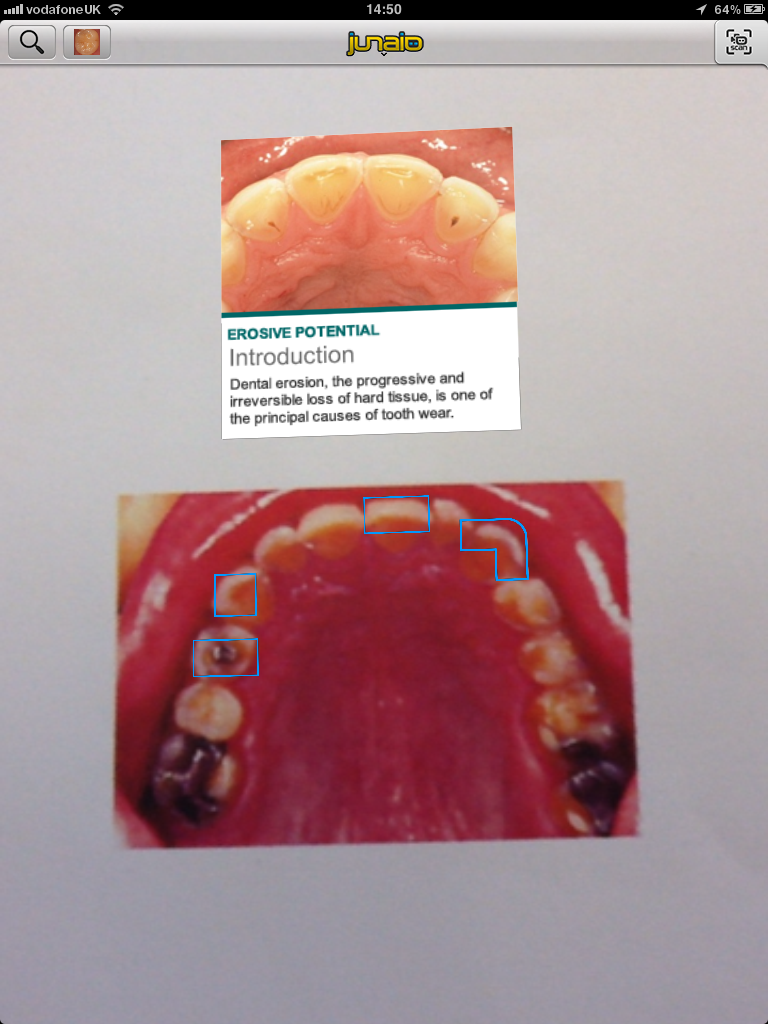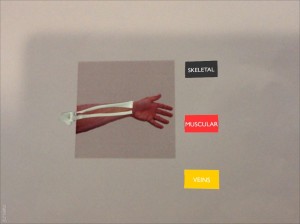 As part of my work researching AR I have been collaborating with other faculties in the University of Manchester to put together some sample content showing how it could be used to enhance the student experience. The first example uses a picture of a patients mouth as a tracking image, then overlays buttons over areas of decay adding contextual information related to the clinical condition. I thought it was important to create a meaningful link from the printed marker and the AR element to increase the user engagement and impact. The user experience is intuitive and requires little guidance, making the learning more immersive than a simple online demonstration. It also places the user at the heart of the activity, particularly appealing to kinesthetic learners that respond to kinesthetic (movement) and tactile (touch) interactions.
As part of my work researching AR I have been collaborating with other faculties in the University of Manchester to put together some sample content showing how it could be used to enhance the student experience. The first example uses a picture of a patients mouth as a tracking image, then overlays buttons over areas of decay adding contextual information related to the clinical condition. I thought it was important to create a meaningful link from the printed marker and the AR element to increase the user engagement and impact. The user experience is intuitive and requires little guidance, making the learning more immersive than a simple online demonstration. It also places the user at the heart of the activity, particularly appealing to kinesthetic learners that respond to kinesthetic (movement) and tactile (touch) interactions.
In other work, I have been collaborating with Dr. Kurt Wilson (Clinical Teaching Fellow) at the Medical School to develop an iBook on prescribing. Certain chapters will include linked activities using AR, alongside other e-learning components such as videos, 3D models and interactive HTML5 widgets. There is real scope in medicine to implement AR experiences to help students understand pattern recognition, a crucial part in decision making processes. I can see the potential use of this in examining x-rays and identifying important elements or abnormalities.
I created the example below illustrating a simple concept for recognising different anatomical elements of a forearm. The user would be able to strip away the skin and look at different parts of the anatomical makeup by clicking on labelled buttons. Although very basic information is displayed, it is extremely visual and with further development could provide a good catalyst for deeper research and study.
As I have stated on countless occasions, development of meaningful and pedagogically sound AR can only be achieved working with an academic, aligning the e-learning to course aims and objectives. Working with Kurt, his enthusiasm is obvious and is central in working towards a common goal of improving the student experience. As an advocate of using innovative learning methods, he can see the potential of technologies such as AR to engage students and build on existing support materials.
In my experience AR is most successful when you are delivering learning in a unique way. Over the next few months I hope to make available further demonstrations showing the ways in which it can be delivered to support otherwise abstract learning concepts in a visual and engaging manner.



Pingback: Innovation in Education – Augmented Reality, a Manchester Showcase | SCARLET (Special Collections using Augmented Reality to Enhance Learning and Teaching)